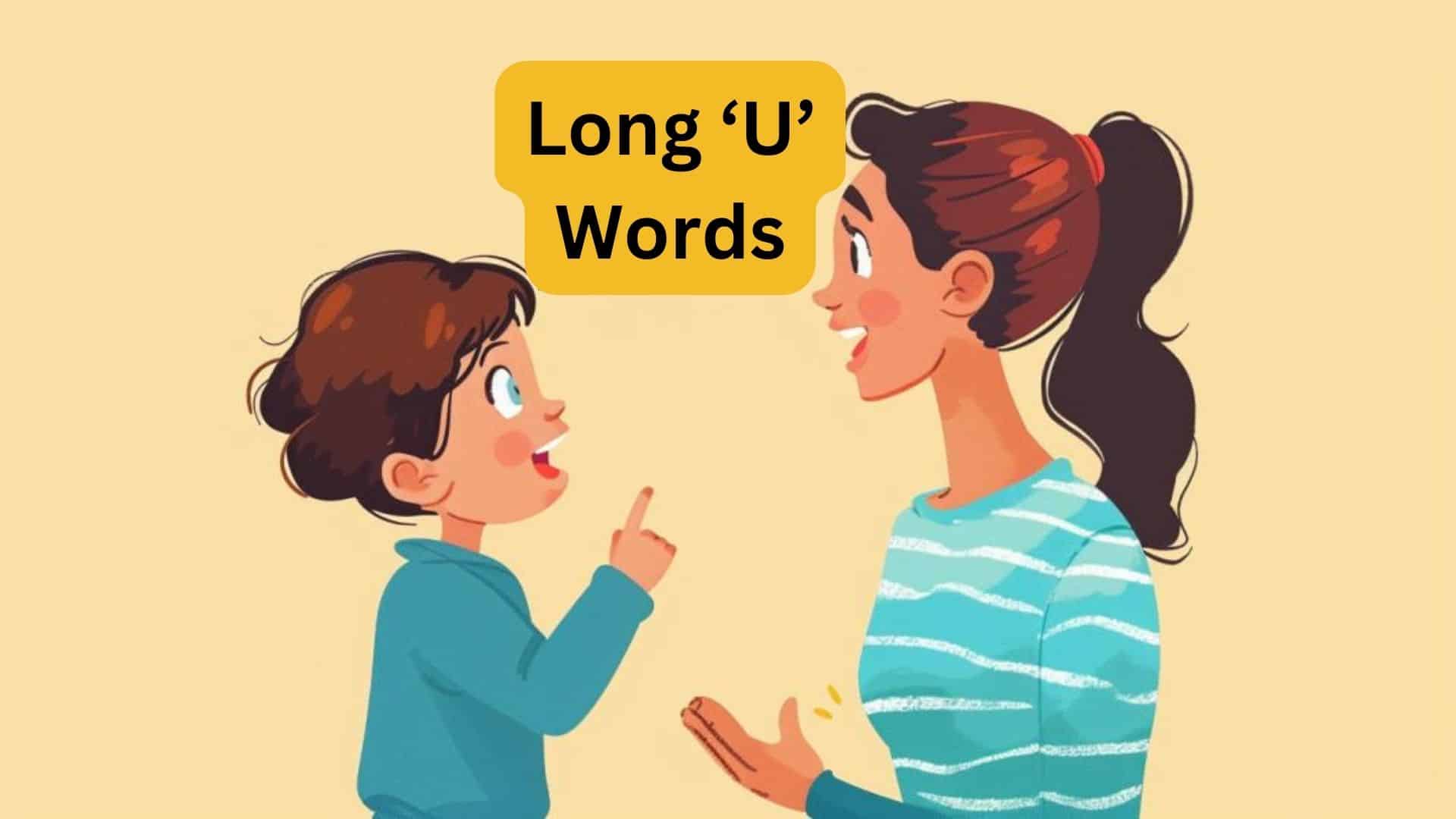Are you struggling to pronounce long U words correctly? Many English learners find words like “tune,” “cube,” and “flute” challenging.
But what if mastering these words could dramatically improve your overall English pronunciation and help you speak more clearly and confidently?
In this blog post, we’ll explore the different sounds and spelling patterns of long U words. You’ll learn practical tips and exercises to perfect your pronunciation of these challenging words.
Get ready to take your English speaking skills to the next level! Keep reading to discover the secrets to mastering long U words and enhancing your English pronunciation.
With our expert guidance, you’ll speak like a native in no time.
What is the Long U Sound?

The long U sound in English can be pronounced in two distinct ways: /yoo/ and /oo/.
Understanding these pronunciation differences is key to mastering long U words and improving your overall English speaking skills.
Examples of Long U Sounds
1. /yoo/ Pronunciation Examples
- Unicorn: “The magical unicorn danced in the meadow.”
- Music: “Listening to music helps me relax.”
- Cute: “The kitten is so cute and playful.”
2. /oo/ Pronunciation Examples
- Moon: “The moon shone brightly in the night sky.”
- Glue: “I need some glue to fix this broken vase.”
- Soup: “A warm bowl of soup is perfect on a chilly day.”
Tips for Long U Pronunciations
Mastering the pronunciations of /yoo/ and /oo/ is essential for clear and effective communication in English.
Tips for Pronouncing /yoo/
1. Start with a ‘y’ Sound
- Explanation: To pronounce /yoo/, combine a consonantal ‘y’ sound followed by an ‘oo’ sound.
- Example: The word “you” in “unicorn” (/ˈyo͞onəˌkôrn/) demonstrates this combination.
- Practice: Repeat words starting with “you,” like “youth,” “use,” and “uniform,” to reinforce the /yoo/ pronunciation.
2. Open Syllables
- Explanation: When the letter ‘u’ appears in an open syllable (ending with a vowel), it usually sounds like /yoo/.
- Examples: Words like unit (/ˈyo͞onit/) and music (/ˈmyo͞ozik/) showcase this pattern.
- Practice: Identify and pronounce more open syllable words such as “utility,” “unique,” and “unicorn” to solidify your understanding.
3. Silent ‘e’ Pattern
- Explanation: When ‘u’ is followed by a consonant and a silent ‘e’, pronounce it as /yoo/.
- Examples: Cube (/kyo͞ob/) and mute (/myo͞ot/) are prime examples of this pattern.
- Practice: Focus on words with the silent ‘e’ pattern, like “fuse,” “mule,” and “huge,” to master this pronunciation rule.
Tips for Pronouncing /oo/
1. Rounded Lips
- Explanation: To pronounce /oo/, shape your lips into a rounded position, as if saying “too.”
- Examples: Moon (/mo͞on/) and food (/fo͞od/) require this rounded lip shape for accurate pronunciation.
- Practice: Emphasize the rounded lip shape while pronouncing words like “school,” “soon,” and “boot” to master the /oo/ sound.
2. Silent ‘e’ Pattern
- Explanation: The ‘u-e’ spelling can also produce the /oo/ sound, similar to the /yoo/ pronunciation.
- Examples: Flute (/flo͞ot/) and tube (/tyo͞ob/) demonstrate this pattern.
- Practice: List and practice words like “rude,” “rule,” and “tune” to reinforce the /oo/ pronunciation with the silent ‘e.’
Practice Strategies for Pronouncing Long U Sounds

Consistent practice is essential for mastering the pronunciation of long U sounds.
1. Using Color-Coded Letters
- Explanation: Differentiating spelling patterns using colors can visually reinforce your learning and help you quickly identify and remember the various patterns associated with long U sounds.
- Implementation: Assign specific colors to each spelling pattern to create a visual association.
- Example: Use blue for ‘ue’ words like “glue” and green for ‘ew’ words like “stew.”
- Practice: Create word lists or flashcards using the color-coded letters and practice regularly to strengthen your visual memory and recognition of these patterns.
- Benefits: Color-coding helps quickly identify and remember different spelling patterns, making it easier to associate the correct pronunciation with each word.
2. Breaking Down Words
- Explanation: Sound blending involves dividing words into individual sounds (phonemes) and then blending them together to form the complete word. This technique helps you focus on each sound and better understand how they combine to create the long U pronunciation.
- Implementation: Practice breaking down long U words into their sounds and then blending them.
- Example: For the word “music,” break it down into “m-u-s-i-c” and then blend the sounds to form “music.”
- Practice: Use this technique with various long U words to reinforce their pronunciation and develop your phonemic awareness.
- Benefits: Sound blending enhances your phonemic awareness and helps you understand the structure of words, making it easier to pronounce them accurately.
3. Using Magnetic Letters or Air Tracing
- Explanation: Engaging in physical activities that involve forming or tracing letters can help reinforce your learning and make it more interactive and enjoyable.
Implementation: Use magnetic letters to form long U words or trace the letters in the air while pronouncing them. - Example: Form the word “cube” with magnetic letters or trace it in the air as you say it.
- Practice: Incorporate these kinesthetic activities into your daily learning sessions to provide hands-on practice and engage your sense of touch and movement.
- Benefits: Kinesthetic activities engage learners who learn best through movement and touch, making learning more interactive and fun.
4. Listening to Recordings
- Explanation: Listening to and mimicking correct pronunciations can improve your pronunciation of long U sounds.
Implementation: Use online dictionaries with audio examples, such as Merriam-Webster, to listen to and repeat long U words. - Example: Look up words like “music” and “moon” in the dictionary and practice saying them along with the recordings.
- Practice: Set aside dedicated time each day to listen to and practice pronouncing long U words, focusing on mimicking the correct sounds.
- Benefits: Listening exercises help you develop an ear for correct pronunciation and familiarize yourself with the subtle nuances of long U sounds.
5. Using Apps for Guided Practice
- Explanation: Educational apps offer interactive pronunciation exercises that can guide you through structured practice sessions and provide immediate feedback on your performance.
- Implementation: Use apps like “Sounds: The Pronunciation App” for guided practice sessions focused on long U sounds.
- Example: Follow the app’s exercises to practice pronouncing long U words and receive feedback on your accuracy.
- Practice: Regularly use these apps as part of your study routine to reinforce your learning and track your progress over time.
- Benefits: Interactive tools provide structured and varied practice opportunities, allowing you to focus on specific aspects of long U pronunciation and receive immediate feedback.
Common Mistakes and How to Avoid Them
Recognizing and addressing common mistakes in pronouncing long U sounds is crucial for accurate communication.
This section will highlight typical errors and provide strategies for avoiding them, enhancing your English speaking skills.
Mispronouncing Open Syllables
1. Understanding the Rule
- In open syllables (ending with a vowel), the ‘u’ usually produces the /yoo/ sound.
- Correctly pronouncing open syllables is essential for clear speech and comprehension.
2. Examples
- Unit: Pronounced as /ˈyo͞onit/.
- Music: Pronounced as /ˈmyo͞ozik/.
Confusing U and U-E Patterns
1. Understanding the Difference
- U Pattern: Produces a short ‘u’ sound as in “cub.”
- U-E Pattern: Produces the /yoo/ sound due to the silent ‘e,’ as in “cube.”
2. Examples
- Cub: Pronounced as /kʌb/.
- Cube: Pronounced as /kyo͞ob/.
Mixing up EW and UE
1. Understanding the Confusion
- EW Pattern: Can produce both /yoo/ and /oo/ sounds.
- UE Pattern: Often produces the /oo/ sound but can also produce /yoo/.
2. Examples
- EW: Curfew (/ˈkərfyo͞o/), stew (/styo͞o/).
- UE: Argue (/ˈärɡyo͞o/), glue (/ɡlo͞o/).
Overgeneralizing OO Spelling
1. Understanding the Rule
Overusing ‘oo’ spelling for the /oo/ sound in inappropriate contexts.
2. Examples
- Incorrect: Floo (correct: flu).
- Correct: Moon, pool.
Exceptions and Rule Breakers
1. Understanding Exceptions
Some words do not follow the standard pronunciation rules for long U sounds.
2. Examples
- Busy: Pronounced as /ˈbɪzi/.
- Bury: Pronounced as /ˈberi/.
Conclusion
Mastering long U pronunciations is essential for clear communication and confidence in speaking English.
By understanding the distinct /yoo/ and /oo/ sounds, recognizing common spelling patterns, and practicing through engaging exercises, you can significantly improve your pronunciation skills.
While challenges may arise, such as mispronouncing open syllables or confusing similar spelling patterns, consistent practice, and effective strategies will help you overcome these obstacles.
So, what’s your next step? Start practicing today and unlock the full potential of your English pronunciation skills.
Remember, with dedication and the right tools, you’ll soon communicate clearly and confidently.
Frequently Asked Questions
How Do You Teach the Long U Sound?
Teach the two long U sounds (/yoo/ and /oo/) using spelling patterns and examples, as well as practice exercises focusing on word recognition and pronunciation.
What is the U Sound Rule?
The long U sound is often pronounced as /yoo/ in open syllables or as /oo/ in various spelling patterns such as ‘ue’, ‘ew’, and ‘oo’.
How to Pronounce U Phonics?
The letter ‘u’ can be pronounced as a long U (/yoo/ or /oo/) or a short U (/ŭ/) sound, depending on the word and spelling pattern.
What is the Long U in Phonetic Transcription?
In phonetic transcription, the long U sound is represented as /yoo/ (e.g., /ˈmyo͞ozik/ for “music”) or /oo/ (e.g., /mo͞on/ for “moon”).









